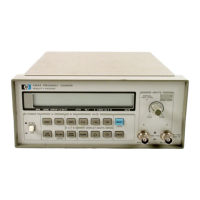•
•
•
8-237. The ON/STBY switch connects the
power
supply and battery
to
the the
counter
circuitry. The
switch
is
a make
before
break type
which
connects
the
minimum
load
R61
to
the
power
supply
before
the
instrument
load
is
disconnected (the
counter
switched
to
standby).
8-238. A
minimum
load
is
connected
to
the
power
supply at all times. The oven oscillator
option
replaces
R61
as
the
minimum
load. You may disconnect
the
battery
from
the
circuit
to
save
battery
power,
in
which
case
the battery will charge
only
and the
charger becomes
the
minimum
load.
8-239.
The rectified
output
of
CR8 goes
to
C29
and
C30,
two
2200
ufd
capacitors that have a
low
series
impedence
and serve
as
the
power
supply filter.
8-240.
To
protect
the
counter
circuitry
from
over-
voltage, a
crowbar
circuit
will
fire
and cause
F2
to
blow.
The
crowbar
circuit
is
formed
by series resistor
RSO
and
SCR
CR9, Zener diodes CR10 and CR13, and
low
pass
filter
C28.
The voltage
on
C29
and
C30
is
monitored
by
CR10
and the
power
supply
output
voltage
of
Q10
is
monitered
by
CR13.
The capacitor
C28
shorts noise spikes
to
ground
so
they
do
not
cause
the
SCR
to
fire.
8-241.
Zener diodes
CR10
and
CR13
are connected
together
in
a descrete,
wired OR
configuration.
The
SCR
will
fire
if
the voltage
on
the
filter
capacitors rises
to
approximately
20
volts
or
if
the
power
supply
output
voltage rises
to
approximately
6.5
volts.
8-242.
Once
the
SCR
fires,
it
latches and causes the
fast
blow
fuse,
F2
to
open. The
crowbar
circuit
is
intended
primarily
for
protection
against external de
over-voltage applied by
the
user
or
shorting
of
the
switching transistor Q10.
8-243. The 5
volt
regulator U7 provides
power
to
switching regulator U9 and
the
switching transistor
driver
Q11. U8 outputs a
2.5
volt
reference
to
U9. U9
uses
the
2.5
volts
for
a reference
to
regulate the
power
supply
output
voltage over
temperature
with
no
adjustments required. U8
is
connected
to
the
refer-
ence
input
of
U9 (pin
2).
8-244. Inside
the
U9 regulator
is
an
oscillator
oper-
ating at
87kHz,
a comparator, and
an
error
amplifier.
The
oscillator
is
used
to
generate a ramp signal that
is
input
to
the
comparator. The
error
voltage
from
L 1
is
fed
through
the voltage
divider
R62
and
R63,
into
the
inverting
amplifier
and comparator
of
U9.
When
the
amplified
error
signal
is
greater than the oscillator
ramp level,
the
comparator
output
(pins
1.1
and
14)
HP
5384A and
HP
5385A
Service
turns
on
the
switching transistor Q10
ra1smg
the
output
voltage. If
the
amplified
error
signal
is
below
the
oscillator ramp level the comparator commands
Q10
to
turn
off.
8-245.
To
insure that Q10 saturates
to
within
.1
volts
of
the
input
voltage, a pulse
of
constant
current
is
drawn
from
the
base
of
Q10 by
the
constant
current
pulse
driver
Q11
and Q12. The constant
current
pulse
driver
circuitry
consists
of
Q11, Q12,
R59
and
RGO.
Normal
operation
produces pulses
of
.6
to
.7 volts
across
R60.
The pulses are driven by pins
11
and
14
of
U9.
8-246.
BATTERY
PACK CHARGER
8-247. Refer
to
Figure 8-54,
A3
Battery
Pack
for
the
following
discussion
on
the
theory
of
operation.
8-248. The battery charger board performs
two
major
functions:
1). It recharges
the
battery
when
low
and,
2).
It delays damaging battery discharge by
turning
off
the de
to
de
converter
in
the
power
supply
on
the
motherboard.
8-249. The battery charger
is
a
two
step
current
charger (hysteresis
loop
charger). A constant
current
of
10
mA
is
always applied
to
the
battery
whenever
external
power
is
applied
to
the instrument. The
charge rate
is
stepped
up
to
approximately
500
mA
if
the
voltage
conditions
of
the battery indicate re-
charging
is
needed and
the
STBY
/ON
switch
is
in
STBY.
8-250. The battery
low
indicator
goes active when
approximately
20
minutes
of
operation
remain.
When
the voltage sensed
at
the de
to
de
converter
input
is
too
low
for
reliable
operation,
the
disabling
com-
parator
circuitry
goes active and shuts
down
the de
to
de converter
on
the
counter
motherboard.
This
reduces
the
battery drain
to
less
than
50
mA. The
counter
can remain in this state
for
24
hours
before
battery damage occurs.
The battery can
be
permanently damaged
if
the
counter
remains
in
the
power
down
state for
more than a day.
To
prevent damage, switch
counters
to
STBY
and
recharge
as
soon as
possible.
NOTE
For
maximum
battery life, keep the battery
fully
charged
as
much
as
possible (connected
to
an
external
power
source)
when
not
in
portable
operation.
8-31

